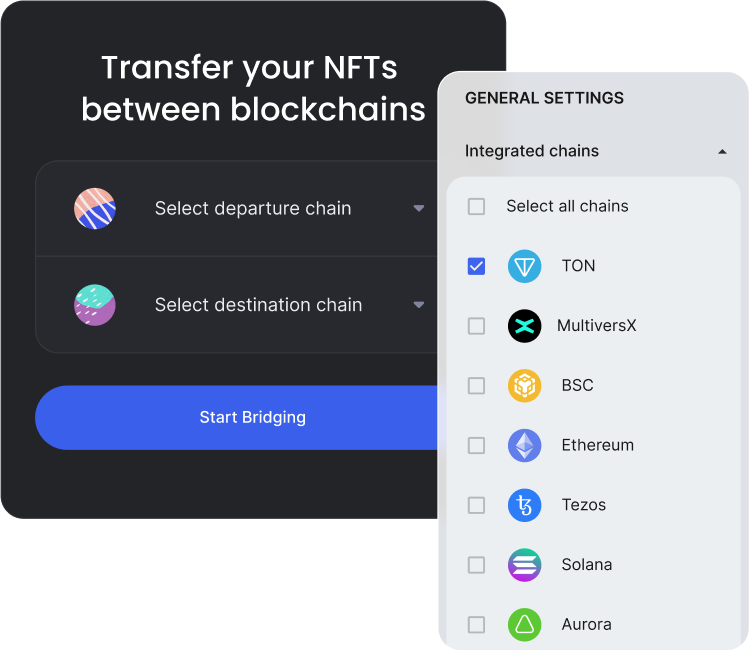Frequently asked questions
The "XP.NETWORK" NFT Bridge embarked on its journey in July 2021 by creating the initial testnet bridge linking MultiversX (Formerly known as “Elrond”) and HECO. This preliminary effort transformed in August 2021, evolving into a sophisticated multichain bridge framework. Subsequent stages involved comprehensive testing across various testnets, including Ethereum Ropsten, BSC, Polygon Mumbai, and Harmony.
These efforts culminated in October 2021, when the bridge achieved its mainnet launch, which marked the establishment of connections among prominent blockchain networks, including Ethereum, BSC, Polygon, Elrond, and Fantom. The subsequent months saw a series of expansions: November witnessed the incorporation of Tron, Avalanche, and xDai; December brought Algorand and Fuse into the fold. The evolution continued steadily, progressively including additional EVM and non-EVM supported chains into the network.
While many bridges are designed for fungible tokens, which are relatively straightforward to create, the availability of solutions for bridging non-fungible tokens (NFTs) is remarkably limited. Moreover, existing NFT bridging solutions establish connections solely between EVM-based chains like Ethereum, Polygon, and a few others, or at best, they link a single non-EVM network such as Solana or Elrond with an EVM network. XP.NETWORK addresses this gap comprehensively by establishing connections across isolated ecosystems, encompassing both EVM and non-EVM chains, resulting in a unified global network of interoperable markets.
Thriving markets inherently depend on the fluid exchange of goods and services. The emergence of NFTs introduced a revolutionary technology for instant, publicly verifiable ownership registration. Essentially, any item that holds value in the physical world, including intellectual property, can be securely registered as NFT. Furthermore, Semi-Fungible Tokens (SFTs) facilitate shared ownership of assets among groups of individuals.
The capacity to seamlessly transfer NFTs and SFTs across diverse blockchain protocols significantly contributes to the liquidity of these tokens. A broader audience exposure inherently increases the potential for successful token sales. Bridges play a pivotal role in making this transfer process reversible. NFTs can be seamlessly bridged to foreign chains to seek out new holders, and subsequently, these NFTs may be repatriated by their new owners to access the goods or services extended to token holders.
1) Non-Coders: This includes NFT product owners, traders, investors, collectors, and artists/creators who might lack coding skills. For their convenience, an intuitive and user-friendly interface is available at https://bridge.xp.network. This interface empowers users to interact with the bridge without requiring coding expertise.
2) Developers: Those proficient in coding can leverage the bridge's capabilities through the bridge JavaScript library, accessible at https://www.npmjs.com/package/xp.network. This library can be effortlessly integrated into front and backend environments, enabling the seamless incorporation of NFT bridging functionality. Developers can harness this library to facilitate NFT bridging behind the scenes, effectively catering to the needs of NFT marketplaces and web3 games within Metaverse ecosystems.
What are the main use cases?
Cross-Chain Gaming
The bridge facilitates scenarios where player teams spanning different blockchains can gather NFT-based artifacts or mine resources and transfer these assets seamlessly from one blockchain network to another.
Cross-Chain MarketplacesIntegrating the XP, the bridge plays a pivotal role in cross-chain marketplace operations.NETWORK library platforms can streamline purchasing NFTs originating from other blockchain networks. This functionality not only enhances user convenience but also leads to substantial savings in terms of both costs and developer efforts.
NFT Projects ExpansionThe bridge is a potent tool for NFT projects aiming to extend their global reach and amplify sales volume and liquidity. By seamlessly connecting diverse blockchain ecosystems, XP.NETWORK empowers NFT projects to engage with a broader audience and tap into previously untapped markets.
The bridge already connects 21 EVM and 9 non-EVM networks.
1.Ethereum2.Binance Smart Chain
3.Polygon
4.Avalanche
5.Fantom
6.Moonbeam
7.Velas
8.Fuse
9.Harmony
10.Gnosis
11.IoTeX
12.Tron
13.Aurora
14.Godwoken
15.GateChain
16.VeChain
18. Skale
19.Abey Chain
10.Caducaus
20. OKC
21.Arbitrum Nova
Non-EVM:
1.MultiversX2.Algorand
3.Tezos
4. Solana
5. TON
6.Secret Network
7. NEAR
8.Internet Computer
9. Casper
VM, short for Ethereum Virtual Machine, represents a pivotal innovation that sets Ethereum apart from Bitcoin. EVM facilitates the integration and execution of third-party code within an active blockchain environment without necessitating halts. Solidity, the original smart contract programming language, enables this capability.
All chains that have adopted the EVM framework share support for Solidity, MetaMask wallet integration, Web3 tools, and Ethereum's JavaScript libraries, among other features. The infrastructure developed for one EVM-based chain can be repurposed with minimal adjustments across other EVM chains, given their closely aligned token standards.
In contrast, Non-EVM blockchains operate on distinct virtual machine architectures, employing their token standards and smart contract languages like Rust, C++, TEAL, Michelson, ink!, and Plutus. While these non-EVM chains might possess technical advantages over EVM networks, the challenge lies in the need for developers proficient in the requisite programming languages. Consequently, constructing a non-EVM chain demands considerable effort.
Due to the intricacies involved, only a few non-EVM NFT bridges exist. Consequently, creating such bridges marks a significant milestone within the industry. Notably, XP.NETWORK stands out as the exclusive NFT bridge catering to MultiversX, Tezos, Algorand, GateChain, NEAR, Aurora, Godwoken, etc., effectively bridging the gap between EVM and Non-EVM chains.
The evolution of our development journey has encompassed several significant milestones: transitioning through versions v1.0, v2.0, and v3.0, and presently culminating in the v3.1 iteration.
In the inaugural v1.0 version, all NFTs were consolidated within a singular contract, albeit bearing distinct token IDs compared to their original counterparts. Subsequently, v2.0 introduced a shift wherein NFTs found their way to individually deployed contracts for each collection. However, this manual contract deployment process proved to be a substantial impediment.
The progression into v3.0 marked a pivotal enhancement facilitated by introducing automated deployment for destination contracts. This innovation streamlined the process and mitigated the challenges posed by manual deployment.
Currently, in v3.1, we've further fortified the system by eliminating another bottleneck - the whitelisting mechanism. This web3 firewall safeguarded the bridge from interaction with potentially malicious contracts, ensuring enhanced security and reliability.
As we continue to advance through these versions, our development efforts remain focused on enhancing efficiency, security, and user experience within the XP.NETWORK ecosystem.
We're working on v4.0 of the bridge. The details of the fundamental changes will be available once the version is tested and released.
The transition to a fully decentralized state for the bridge relay validators is slated to occur with the forthcoming release v4.0. This significant update will open the doors for any individual to partake as a validator, thereby contributing to heightened stability and enhanced security of the bridge's operations.



